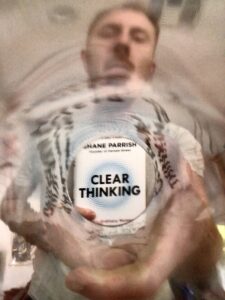 Whether or not we are consciously aware of it, most of us go through our daily lives functioning on autopilot. We have our habits and our ways of doing things, and for our day-to-day tasks, they work. Consistently making our decisions this way, however, actually moves us farther away from the success we seek. In his book, Parrish suggests that we should be making our decisions—the important ones—with rationality and purpose. This makes obvious sense, and so the question becomes how do we go about doing this?
Whether or not we are consciously aware of it, most of us go through our daily lives functioning on autopilot. We have our habits and our ways of doing things, and for our day-to-day tasks, they work. Consistently making our decisions this way, however, actually moves us farther away from the success we seek. In his book, Parrish suggests that we should be making our decisions—the important ones—with rationality and purpose. This makes obvious sense, and so the question becomes how do we go about doing this?
The first thing we must understand about ourselves is that our human brains are emotional (and reactionary) first and foremost, which is our ingrained, evolutionary behavior. Our rationality and analytical thinking comes into play second. Knowing this, it is important not to make decisions with our emotional and reactive selves. Are we tired? Hungry? Angry? If so, we should probably wait to make that important choice. We need to hone the skill of recognizing when we are emotional and allowing ourselves to take the time necessary to come back to equilibrium. Only once we have had time to calmly and coolly assess the situation and circumstances can we make the best decision.
Another major aspect of decision making is diagnosing the correct problem before we begin to solve it. Trying to increase sales when customers are complaining about poor product design, for example, or changing a baby’s diaper when they actually want to be fed will get us nowhere. This is a problem that we often see in group settings, when coworkers assemble for a meeting and immediately start pitching ideas before anyone has had a chance to agree on what the problem actually is. Parrish even suggests that breaking a meeting up into two parts can be helpful, with the first one for diagnosing the problem, and the second one for prescribing the solution.
It is not just important to consider when we make decisions (are we in the right state of mind?), or how we make them (are we targeting the correct problem?) but also why we are making them. Why are we choosing one particular course of action over another? What are the second and third level outcomes we might expect to occur, and how might these potential scenarios change the decision we are making now?
Let’s say we are working for a company that is going out of business, and we are faced with unemployment. Should we look for a similar job in our industry? Should we change industries and try our hand at that creative endeavor we always wanted to try? Should we go back to school and get a better degree, so that we can get a job that pays more in the future? These are all important questions to consider, but let’s take things a step further. If we look for a similar job right away, how long might we expect to look before finding one? Are they available in our current location, or would we have to move? Let’s say we choose to pursue a creative endeavor instead: how much can we reasonably expect to earn doing it? Is that enough to support us and our family? And what if we go back to school, is there a program nearby that matches our area of interest? How much do we have saved up to get us through the year(s) of education? What can we reasonably expect to make at a new career assuming we complete the education needed? The possibilities to consider quickly multiply.
“Avoiding responsibility is a recipe for misery,” writes Parrish, “and the opposite of what it takes to cultivate good judgment.” What this means is that knowingly taking on important responsibilities is the best way to become better decision makers because the best way to improve at anything is to put ourselves in a position where we have to do it. This includes making decisions. We must keep in mind the when, how, and why we are making decisions, and then we must get out there and make them!


